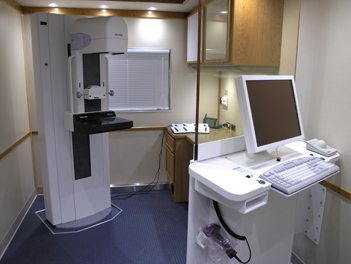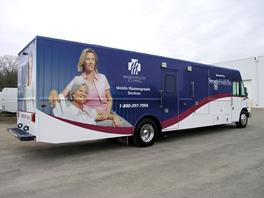
The Clinic chose the Hologic Selenia digital mammography system based on several factors, including size, cost and image quality.
The Outreach Services Program is an integral part of healthcare delivery at Marshfield Clinic, a large group medical practice and private research center. Based in Marshfield, Wisc., the program brings much needed care to rural areas with limited access to state-of-the-art technology.
In May 2007, the clinic became the first facility in the Midwest to offer digital mobile mammography. From funding through coach design, Marshfield understands the challenges of integrating digital mammography with a mobile platform.
“It’s all about mammography access. Whether it’s women in an underserved, rural area or women who are simply unable to get away from work, there’s a huge appreciation for the service we provide,” said Myron Gadke, mobile imaging manager.
Equipment Selection
Marshfield chose the Hologic Selenia digital mammography system based on several factors, including equipment size, detector size, cost, and image quality. Radiologists thought the images were “absolutely beautiful.”
“At the end of the day, it can be a great machine, but if the image quality isn’t there, it’s meaningless to our radiologists,” said Gadke.
Hologic’s reputation as a women’s health leader was also important.
“Hologic is a women’s imaging company. A lot of vendors make mammography equipment, but they make lots of other equipment too. I believe that when you do one thing, you tend to it very well,” said Gene Santilli, system radiology director.
Planning and Marketing
Marshfield did extensive planning to identify target markets and screening locations, and generated interest among women and community leaders.
Establishing relationships with key referral sources was critical. Gadke reached out to county coordinators, human resources departments and physicians. As a result, the coach was booked to capacity before it ever hit the road.
“You need to build relationships with the communities you’re going to be working with because they will eventually become your referral network,” said Gadke.
To fill the occasional vacancy, Gadke markets directly to patients. In January 2009, the mobile program had 59 available days; after a direct marketing campaign, it was once again booked to capacity.
Coach Design
Marshfield played a significant role in the van’s design. The clinic worked with LDV Mobile Solutions, the largest specialty vehicle supplier in the U.S., which provides integrated end-to-end mobile solutions.
Environmental controls were a major concern. Marshfield insulated the van and installed two sources of heat and air conditioning to maintain the exact temperature for the equipment. To maximize patient comfort, they also focused on aesthetics to create a soothing, relaxed interior.
“A lot of women we’re seeing for screening have never had a mammogram before. They’re apprehensive to begin with, so we’ll do anything we can to make it more comfortable,” said Gadke.
Though largely satisfied with the design, Gadke would make some changes, including setting up each room in its own zone for more efficient heating and cooling, and replacing the roof air conditioner with a quieter forced air system. Also, a larger 48-foot trailer would provide extra space and the ability to detach the trailer from the tractor in the event of engine problems.
Infrastructure
Marshfield had to determine the best way to transmit digital images from the coach to the radiologists’ workstation quickly and securely. They investigated several options, and ruled out transferring images via laptops or satellite technology.
The clinic chose a method that was both efficient and secure – a network connection at outreach clinics that allowed for a direct image transfer to the workstation upon acquisition. The result is a streamlined workflow that enables some radiologists to finish the interpretation before the patient is checked out.
Funding
To launch the digital mobile unit, Marshfield focused on securing both short-term and long-term funding. Short-term resources were used to get the project off the ground – purchasing the coach, equipment, storage devices, and so on – and fund the program’s operation for the first 12 months. At the same time, Marshfield began exploring options for long-term funding.
“It takes time to build a successful mobile program and you want to be able to continue operation if current funding sources don’t continue,” said Gadke.
Using private funding sources required Marshfield to educate those involved. Communicating their goals – and providing statistics to demonstrate success – was essential to maintaining support.
Digital Mobile Mammography: A Successful Implementation
After only two years, Marshfield achieved its goal of increasing mammography access. To support the increased demand, Marshfield will launch a larger mobile unit with digital mammography and bone density screening by the end of 2009.
Marshfield’s experience shows that with careful planning, a successful mobile mammography program can broaden access to technology and benefit the institution as a whole.



 December 17, 2025
December 17, 2025 









